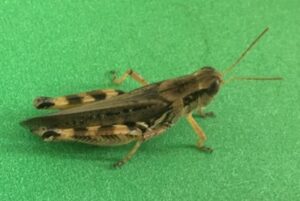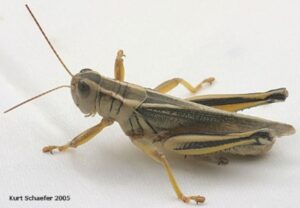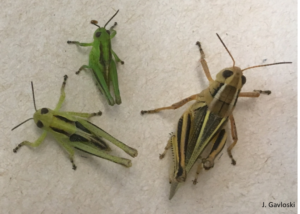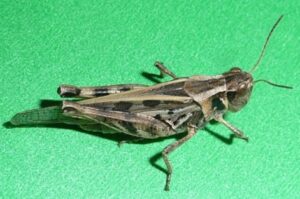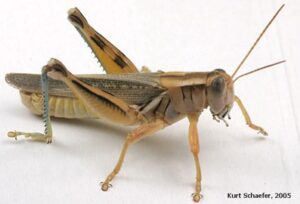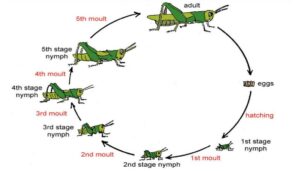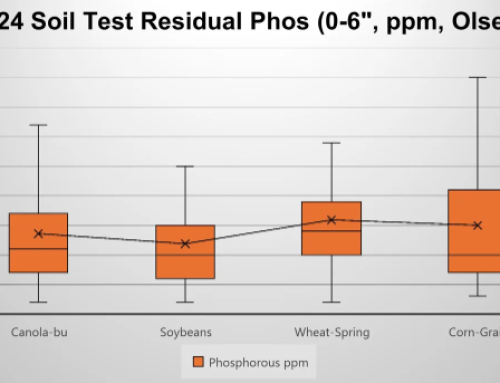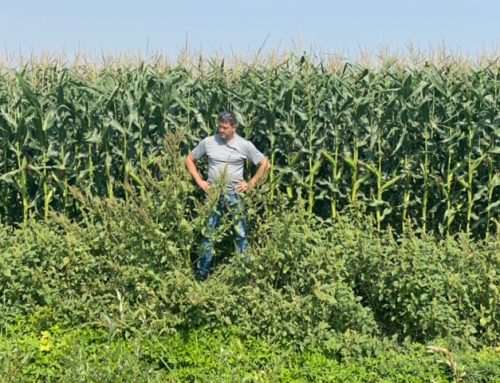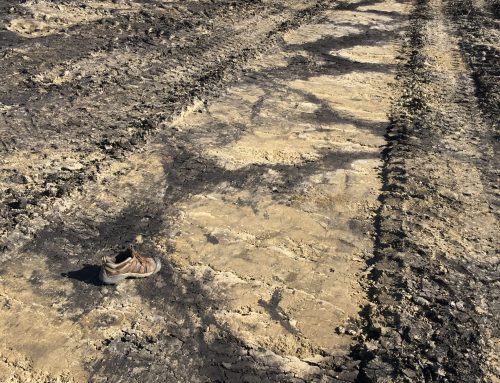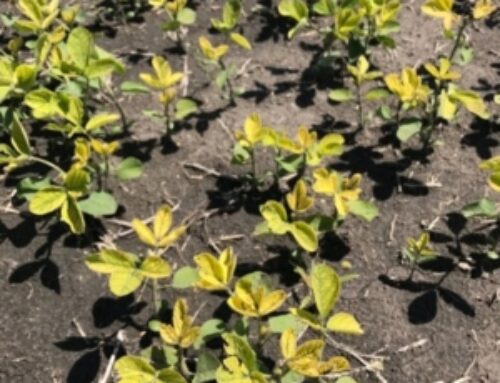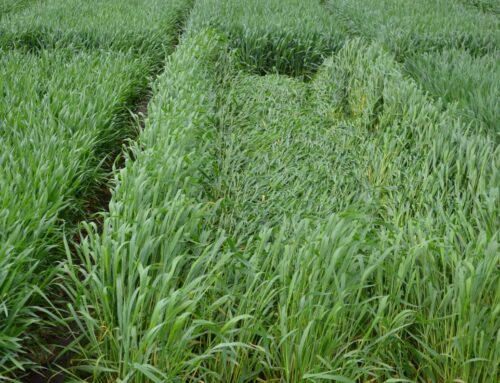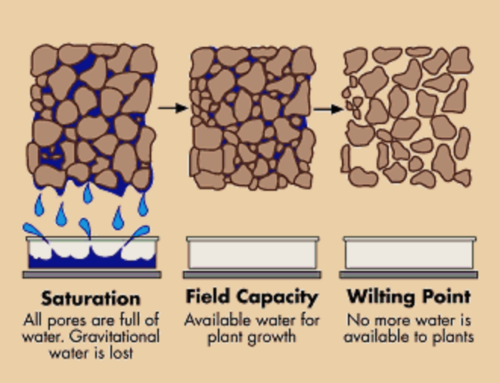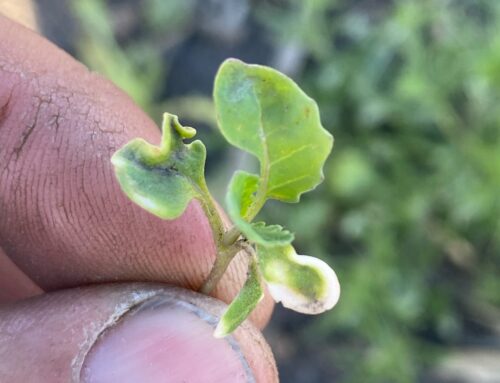Fields are at various stages across the Red River Valley and grasshopper pressure has started to become evident for many. While pest presence and development vary between areas and between fields, it’s important to be informed about pest lifecycles, behaviors, scouting techniques, thresholds, and control options.
Read on for more information on grasshoppers in the Red River Valley, or download this whitepaper.
Types of Grasshoppers
There are four types of damaging grasshopper species in Manitoba:
Migratory Grasshoppers
Migratory grasshoppers vary considerably in terms of their colour and physical characteristics.
Generally, this species is brown to yellow in colour with a dark stripe behind each eye.
They also have a series of black bands on their hind legs, and small dark rectangular spots on their forewings. Nymphs have black stripes on their heads.
Migratory grasshoppers feed on grasses and broadleaf plants.
Two-striped Grasshoppers
Two-striped grasshoppers are the largest of the four damaging species in Manitoba.
They have two pale stripes from their eyes to the tips of their forewings, and a solid black stripe on their hind legs.
Another two stripes can also be found on the thorax, behind the head.
Nymphs can be green, tan, or yellow/orange in colour.
Two-striped grasshoppers are more commonly found around heavy texture soils, and while they feed on both grasses and broadleafs, they actually prefer broadleafs.
Clear-winged Grasshoppers
Similar to the two-striped grasshopper, the clear-winged grasshopper species also has two stripes on its back.
They also have brown spots on their forewing and contrary to their name, not totally clear wings due to dark patches along the wing surface.
Clear-winged grasshoppers are primarily grass feeders, tending to leave broadleaf plants alone.
Packard Grasshoppers
Adult packard grasshoppers are grey to dark yellow in colour with light stripes behind their eyes.
They can also have blue or green tones for the last two segments of their legs.
Packard grasshoppers are typically found in light textured soils and they feed on both grasses and broadleafs.
It is important to note that not all grasshoppers are pests in crop production.
There are a few simple rules of thumb to follow when trying to decide whether or not a grasshopper is economically detrimental:
- If a grasshopper is spotted flying before June, it is not a threat to the crop.
- If a grasshopper is flying and you can see the colour of its wings
(i.e. they are black, red, yellow, or orange) it is not a pest. - Grasshoppers that make noises (i.e. clacks, clatters, or sings) are not pests
(pest grasshoppers are silent).
Grasshopper Lifecycles
Only one lifecycle of grasshoppers occurs per year across the Canadian prairies.
Eggs are laid in batches within the soil (fields, ditches, roadsides, and along fencelines) to overwinter. Hatching typically begins in late May and nymphs (small grasshoppers with short wing buds) will emerge in early to late June. They will then progress through various instar stages until they are considered full-sized adults, between 20 and 80 millimeters in length, which are present until mid to late September.
Damage, Scouting, & Thresholds
Damage
Grasshopper damage occurs as torn strips or chewed bits of individual leaves; later in the season, feeding can shift to clipping heads of cereal crops or pod-chewing in pulse crops.
Scouting
There are 3 scouting techniques for assessing grasshopper presence and damage.
- The most common method is utilizing “meter-square counts” which involves counting the number of grasshoppers that jump in front of you in the field. Pick a spot that is about 5 paces in front of you and as you walk to that spot, count the number of grasshoppers that move away from the area. Repeat this 5 times, walking in a Z or W pattern (don’t walk straight).
- Defoliation is the second way to measure economic threshold for grasshoppers, and it involves selecting 2 plants at random from 5 different areas of the field and estimating the percentage of defoliation. The defoliation method is most commonly used in soybeans.
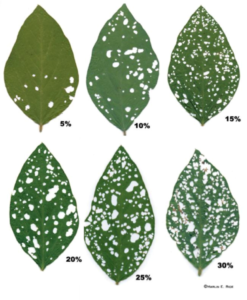
- Use a sweep net. Using a sweep net to scout for grasshoppers is typically done earlier in the season to determine the instar stages of the pests present, and when an insecticide application may be warranted.
Thresholds
Threshold levels can vary between crop types and fields based on many factors such as crop stage.
One rule of thumb some people go by is 10 grasshoppers per meter-square across all crops. However, in cereal crops the threshold may be between 8 and 13 grasshoppers per square meter, or 18 to 20 grasshoppers per square meter and visible crop damage early in the season!
Control Options & Efficacies
There are several grasshopper control options for the various crop types grown in the Red River Valley – from active ingredients such as chlorantraniliprole and deltamethrin to lambda-cyhalothrin and malathion. The control options have a variety of benefits and challenges, especially in terms of efficacy, mode of action, and application timing.
Chlorantraniliprole
Chlorantraniliprole is an active ingredient from the diamide class. It is absorbed through ingestion, binding to a specific receptor in the muscles of insects, called the ryanodine receptor. At this point, muscle cells will begin to leak calcium, eventually causing the insect to become paralyzed and die. Sources state that chlorantraniliprole is also toxic to insect eggs, larvae, and pupae on contact.
Feeding can cease within 7 minutes after spraying chlorantraniliprole, but it can take 4+ days for grasshoppers to die once they become lethargic and immobile. Continued feeding should not be an issue between the tie of consumption and death.
Products containing chlorantraniliprole claim to have a residual period between 7 and 21 days, and the ability to control insects from hatch to adult.
Deltamethrin
Deltamethrin is a pyrethroid absorbed through both contact and ingestion. It disrupts the natural function of the nervous system in insect pests, causing them to weaken and die.
It is recommended that products containing deltamethrin be sprayed when grasshoppers are in the 2-4 nymphal stage (prior to wing development). These products claim to have a residual period up to 10 days, however they can have decreased efficacy in excessive heat. Control may also be limited on grasshoppers residing under leaves.
Lambda-Cyhalothrin
Similarly to deltamethrin, lambda-cyhalothrin is a pyrethroid absorbed through both contact and ingestion with similar effects.
Source indicate lambda-cyhalothrin may have a half-life of just 5 days. It is recommended to spray products containing lambda-cyhalothrin when grasshoppers are relatively small still (again, the 2-4 nymphal stage).
Malathion
Malathion is an organophosphate that works on contact by binding to an enzyme in the space between nerves. Upon binding to the enzyme, malathion prevents nerve signals from stopping – the constant nerve signals make it so the insects cannot move or breathe normally until they die.
Sources indicate products containing malathion have a residual period between 2 and 18 days.
In summary, spray decisions should be based on a number of factors, including insect presence, stage of development, level of defoliation, crop stage, and weather patterns. Perimeter spraying can be enough to manage grasshopper populations and minimize economic damage some years, although this is highly dependent on the factors listed. Regular scouting is the best way to monitor populations and assess spray timing and thresholds.
Contact insecticides such as deltamethrin, lambda-cyhalothrin, and malathion, should be applied to maximize direct contact with the grasshoppers for the greatest effect. These products should be sprayed when grasshoppers are actively feeding – in temperatures between 21 and 27ºC, under clear skies with little to no wind. The majority of daily feeding takes place in the morning.
A big question is, do we spray when the grasshoppers are smaller and easier to control, with little residual affect on ones that emerge and develop later in the season, or do we wait to spray in order to obtain more control throughout the season whilst allowing current pest to continue feeding and developing in the meantime?
Resources & References:
Prairie Pest Monitoring Network – Week 6 Outlook (June 17, 2022)
Prairie Pest Monitoring Network – Week 5 Outlook (June 10, 2022)
Prairie Pest Monitoring Network – Grasshopper Monitoring Protocol
Manitoba Pulse & Soybean Growers – Grasshopper Information & Assessment
Sask Pulse Growers – Grasshoppers in Pulse Crops
Manitoba Crop Alliance – Grasshopper Forecasting, Monitoring, & Management
Canola Council of Canada – Grasshopper Information Guide
National Pesticide Information Center – Chlorantraniliprole
National Pesticide Information Center – Deltamethrin
National Pesticide Information Center – Lambda-Cyhalothrin
National Pesticide Information Center – Malathion
National Pesticide Information Center – Malathion Technical Guide


